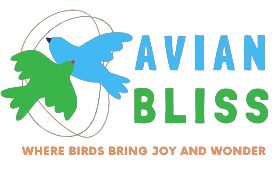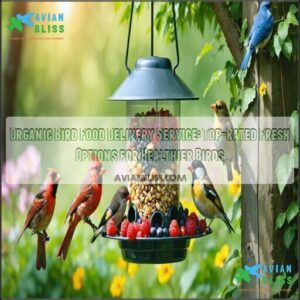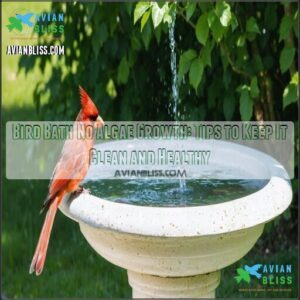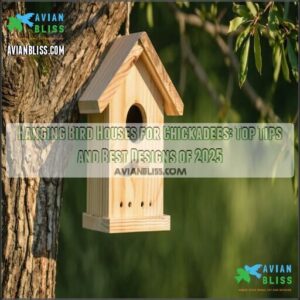This site is supported by our readers. We may earn a commission, at no cost to you, if you purchase through links.
You’ll find over 25 species of backyard birds of Iowa throughout the year.
Northern Cardinals flash their bright red plumage year-round, while American Goldfinches (Iowa’s state bird) trade winter olive-brown for summer sunshine-yellow.
Black-capped Chickadees announce themselves with their cheerful "chick-a-dee-dee" calls, often the first to discover your new feeder.
Blue Jays, American Robins, and House Finches are common sights too.
Each species has unique feeding preferences—some prefer sunflower seeds while others can’t resist suet or nectar.
Understanding these preferences might just transform your ordinary backyard into Iowa’s most popular bird destination.
Table Of Contents
- Key Takeaways
- Common Backyard Birds Found in Iowa
- Resident Birds of Iowa
- Identification Tips for Iowa Birds
- Attracting Iowa Birds to Your Yard
- Birding Organizations in Iowa
- Bird Watching Locations in Iowa
- Invasive Species Impacting Iowa Birds
- Iowa’s Backyard Birds Habitation Guide
- Iowa Birds’ Behavior, Migration, and Range
- Iowa’s Birds in Different Environments
- Frequently Asked Questions (FAQs)
- What are the most common birds in Iowa?
- Where can I find common birds in Iowa?
- What is the best time to observe common birds in Iowa?
- What is the role of common birds in Iowa’s ecosystem?
- How can I attract common birds to my yard in Iowa?
- How do I identify a bird in my backyard?
- What is the invasive bird in Iowa?
- What birds stay in Iowa all year round?
- What is the most rare bird in Iowa?
- What are the most common backyard birds in Iowa?
- Conclusion
Key Takeaways
- You’ll find over 25 species of backyard birds in Iowa throughout the year, including year-round residents like Northern Cardinals and Black-capped Chickadees, summer visitors like Ruby-throated Hummingbirds, and winter visitors like Dark-eyed Juncos.
- You can attract more birds to your Iowa yard by installing the right feeders (tube feeders with nyjer for finches, hopper feeders with black oil sunflower seeds for cardinals), providing water sources, and planting native species like purple coneflowers, serviceberry shrubs, and little bluestem grass.
- Iowa’s diverse habitats support different bird species—look for meadowlarks and mourning doves in open fields, woodpeckers and nuthatches in forests, and herons and wood ducks near wetlands and waterways.
- You’ll improve your bird identification skills by focusing on size, feather patterns, beak shapes, and distinctive calls like the Black-capped Chickadee‘s "chick-a-dee-dee" or watching for unique behaviors like nuthatches moving headfirst down tree trunks.
Common Backyard Birds Found in Iowa
Throughout the four seasons, Iowa backyard birds transform your garden into a living field guide of color and song.
You’ll spot the Northern Cardinal, Iowa’s most common backyard visitor, its crimson plumage a striking contrast against any backdrop.
Black-capped Chickadees bring personality with their distinctive "chick-a-dee-dee" calls, the number of "dees" actually signaling predator threat levels.
Blue Jays command attention with their vibrant blue feather patterns and bold crest, while American Goldfinches—Iowa’s state bird—transition from winter drab to summer gold before your eyes.
For successful bird watching in Iowa, observe White-breasted Nuthatches with their unique headfirst descent down tree trunks and Dark-eyed Juncos hopping below feeders during colder months.
Understanding these beak shapes and feeding preferences helps reveal the full diversity of bird species visiting your Iowa backyard. By creating a bird friendly environment, you can attract a wide variety of species to your yard.
Resident Birds of Iowa
Iowa’s resident birds create a year-round backyard spectacle, from the Northern Cardinal’s flash of red against winter snow to the American Goldfinch’s bright summer plumage.
You’ll find these faithful avian neighbors at your feeders during all seasons, with some species staying put while others arrive for summer breeding or winter refuge.
All-Year Birds
Moving from common backyard birds to those that call Iowa home year-round, you’ll find faithful feathered friends in every season.
Moving beyond fleeting visitors, Iowa’s resident birds become familiar companions through all seasons—steadfast friends in feathered form.
Iowa’s year-round residents bring constant joy to backyard birding enthusiasts:
- Northern Cardinals remain loyal to their nesting sites, their crimson feathers a striking contrast against winter snow
- Black-capped Chickadees visit feeders daily, their curious nature and "chick-a-dee-dee" calls turning the coldest days warm
- Blue Jays announce their presence loudly, their intelligence on display as they cache seeds for later use
These Iowa bird species have adapted perfectly to local bird habitats.
You’ll spot White-breasted Nuthatches scrambling down tree trunks headfirst and Downy Woodpeckers clinging to suet feeders.
With proper feeding tips – black oil sunflower seeds work wonders – these backyard friends will make your yard their permanent home.
Summer Visitors
During summer months, Iowa welcomes a colorful array of avian visitors to your backyard.
The Eastern Meadowlark graces open fields with its bright yellow breast and flute-like song, often perching on fence posts. Listen for the distinctive "dick-dick-cissel" call of the Dickcissel in tall grasses nearby.
Ruby-throated Hummingbirds zip through in late summer, fueling up on nectar before their southern journey. The Gray Catbird and House Wren add their voices to the morning chorus, while Baltimore Orioles flash orange as they visit feeders.
Common Yellowthroats skulk through low vegetation, recognizable by their distinctive black mask. Watch for Barn Swallows swooping for insects overhead.
These summer residents display their breeding plumage while engaging in active nesting habits throughout your yard.
Winter Visitors
While summer birds head south, Iowa welcomes a new cast of feathered friends as temperatures drop.
Dark-eyed Juncos arrive in flocks, their slate-gray backs and white bellies standing out against snowy landscapes.
These "snowbirds" hop beneath feeders, cleaning up fallen seeds.
You’ll notice Pine Siskins, Red-breasted Nuthatches, and American Tree Sparrows joining your regular backyard birds.
During particularly harsh winters, even Purple Finches and Evening Grosbeaks might make surprise appearances.
Winter bird watching in Iowa rewards patient observers with:
- Dark-eyed Juncos, nicknamed "snowbirds," signaling winter’s official arrival
- White-breasted Nuthatches climbing headfirst down tree trunks, defying gravity
- American Tree Sparrows sporting their distinctive rusty caps and central breast spots
Identification Tips for Iowa Birds
Glancing across your Iowa backyard, identifying birds becomes simpler when you know what to look for.
Focus on Bird Size first—is it thumb-sized like a Chickadee or smartphone-sized like a Cardinal? Study Feather Patterns and coloration next; you’ll soon distinguish between a goldfinch’s bright yellow and a sparrow’s mottled brown. Pay attention to Beak Shapes too—seed-eaters have thick, short beaks while insect-hunters sport slender ones.
Don’t overlook Wing Spans during flight or Tail Feathers when perched. Iowa bird identification often hinges on these details.
- Listen for the Black-capped Chickadee’s distinctive "chick-a-dee-dee" call
- Watch for the Northern Cardinal’s crest bobbing as it feeds
- Notice how nuthatches move headfirst down tree trunks
- Spot Dark-eyed Juncos by their characteristic white outer tail feathers
Using a bird identification guide can help you improve your skills and learn more about the birds you spot.
Keep binoculars handy—you’ll spot more backyard birds with each practice session.
Attracting Iowa Birds to Your Yard
You’ll transform your Iowa yard into a vibrant bird sanctuary by providing essential elements that appeal to local species.
Creating a bird-friendly habitat with diverse food sources, clean water, and protective cover will attract colorful visitors like Northern Cardinals, American Goldfinches, and Black-capped Chickadees throughout the seasons, making it a haven for local species.
Bird Feeders and Bath Tips
Now that you can identify Iowa’s birds, let’s talk about attracting them to your yard.
Smart feeder placement is key – position feeders 10 feet from windows or closer than 3 feet to prevent bird strikes.
Choose the right feeder for your target birds and clean monthly with a 10% bleach solution to prevent disease.
Understanding bird feeding strategies is vital for a successful backyard bird sanctuary.
| Bird Type | Feeder Style | Seed Selection |
|---|---|---|
| Finches | Tube feeders | Nyjer (thistle) |
| Cardinals | Hopper feeders | Black oil sunflower |
| Woodpeckers | Suet cages | Suet cakes |
Don’t forget bird baths!
Moving water features attract more species, and heated baths provide essential winter hydration, making them a crucial part of your bird feeding strategies to create a welcoming environment for various bird species, including finches and cardinals.

Native Plants for Birds
Native plants serve as nature’s buffet for Iowa backyard birds, providing essential food, shelter, and nesting materials throughout the year.
Native plants create living bird sanctuaries, offering Iowa’s feathered residents exactly what they need through every season.
Transform your yard into a bird paradise with these local gardening tips:
- Plant purple coneflowers and black-eyed Susans for their seed heads that goldfinches and chickadees will visit even in winter.
- Establish serviceberry or elderberry shrubs that produce berries cardinals and cedar waxwings can’t resist.
- Include wild bergamot and cardinal flower for natural nectar that attracts hummingbirds better than any feeder.
- Add little bluestem grass for ground-feeding juncos and sparrows who’ll gather seeds while finding protection.
Bird-friendly shrubs don’t require constant maintenance like feeders do. Native pollinator plants support the insect populations that parent birds need to feed their young. For best results, choose plants native to Iowa’s specific growing conditions. Using the right Iowa bird seeds can also enhance the attractiveness of your yard to various bird species. This approach will help create a nature’s buffet and a bird-friendly environment,
Birding Organizations in Iowa
Throughout Iowa, bird-focused organizations serve as essential hubs for enthusiasts and conservation alike.
The Iowa Audubon Society and Iowa Ornithologists’ Union offer excellent volunteer opportunities to help protect wildlife refuges and contribute to habitat preservation.
Bird Friendly Iowa provides resources for creating bird-safe environments.
These groups host regular field trips, educational workshops, and citizen science projects that monitor bird populations.
By joining, you’ll connect with fellow bird lovers while supporting conservation efforts across the state’s diverse ecosystems.
Bird Watching Locations in Iowa
Iowa offers several prime locations where you’ll spot diverse bird species throughout the year.
You can observe everything from wading birds at Saylorville Reservoir to woodland species at Otter Creek Marsh Wildlife Area.
Saylorville Reservoir
While Iowa hosts numerous birding organizations, the natural habitats provide the real excitement. Saylorville Reservoir stands out as one of Iowa’s premier bird watching locations.
This 17-mile impoundment on the Des Moines River serves as a critical stopover in the Central Flyway, with over 325 recorded species. The U.S. Army Corps of Engineers manages water levels to create ideal wetland habitat for diverse reservoir birds.
Visit during these peak seasons:
- Spring – spot Piping Plovers, Caspian Terns, and 25+ warbler species
- Summer – watch for egrets, herons, and Osprey around the shorelines
- Fall – observe Red-throated Loons and various migrating sandpipers
- Winter – enjoy Bald Eagles and hardy waterfowl braving the cold
Don’t miss Jester Park’s bird blind for close-up views or the dam’s pull-offs for scanning open water. Conservation efforts maintain this birding paradise year-round.
Otter Creek Marsh Wildlife Area
Otter Creek Marsh Wildlife Area offers exceptional bird watching opportunities within its diverse wetlands.
When you visit this premier Iowa birding destination, you’ll encounter a rich variety of marsh birds in their natural habitat.
| Bird Species | Best Time to Visit | What to Bring |
|---|---|---|
| Red-winged Blackbird | Spring-Summer | Binoculars |
| Great Blue Heron | Dawn or Dusk | Camera |
| Northern Harrier | Fall Migration | Field Guide |
The creek ecosystem supports vital wildlife habitat where wetland conservation efforts have created ideal conditions for bird migration. You’ll spot Iowa bird species like wood ducks and sandhill cranes amid the peaceful wetlands.
Invasive Species Impacting Iowa Birds
The silent invasion of non-native birds creates significant challenges for Iowa’s native species through relentless competition for resources.
European Starlings, House Sparrows, and Eurasian Collared-Doves disrupt local ecosystems in several ways:
- House Sparrows aggressively claim nesting cavities, often killing native birds in the process
- European Starlings displace woodpeckers and bluebirds, causing population declines
- Disease transmission occurs when invasive species spread H5N1 and salmonella to native birds
- Habitat displacement forces indigenous species to abandon traditional breeding grounds
To protect bird conservation in Iowa, install starling-proof birdhouses with 1½-inch entrance holes and use feeders that discourage invasive species while supporting native populations, which helps in relentless competition for resources and prevents disease transmission and habitat displacement, ultimately aiding in the conservation of native species and reducing the impact of invasive species.
Iowa’s Backyard Birds Habitation Guide
You’ll find Iowa’s backyard birds in three main habitats where they establish territories, feed, and raise their young.
Each habitat type supports different bird species, with cardinals preferring woodland edges, meadowlarks thriving in open fields, and herons frequenting wetland areas.
Open Fields and Meadows
When spring arrives, Iowa’s open fields and meadows transform into vibrant bird sanctuaries. The Eastern Meadowlark stands out with its bright yellow belly and distinct black "V" marking on its chest. Listen for their melodic whistles that carry across grasslands.
These grassland birds face significant habitat loss as fields convert to cropland. You’ll notice their foraging behavior differs – meadowlarks probe the soil for insects, while Mourning Doves pick seeds directly from the ground.
- To help: Plant native prairie grasses like big bluestem and add wildflowers such as coneflowers and black-eyed Susans to your yard.
Iowa bird species that depend on these open spaces need your help. The Iowa bird species list includes several grassland specialists worth adding to your bird watching checklist. By preserving even small patches of meadow habitat, you’re supporting these beautiful creatures against ongoing habitat pressures. Planting native grass seeds can help restore their natural environments.
Forests and Woodlands
Moving from open spaces to wooded areas, forests and woodlands host some of Iowa’s most engaging bird species. These habitats support a rich diversity of backyard birds that thrive among various tree species.
The following table outlines some key species and their habits:
| Bird Species | Preferred Habitat | Finding Tips |
|---|---|---|
| White-breasted Nuthatch | Mature forests | Watch for headfirst descent on trunks |
| Downy Woodpecker | Dead timber | Listen for drumming sounds |
| Black-capped Chickadee | Mixed woodlands | Spot in mid-canopy layers |
| Northern Cardinal | Forest edges | Spot red against green foliage |
| Red-bellied Woodpecker | Old growth trees | Check for climbing behavior |
Forest floors offer feeding grounds while the canopy layers provide nesting sites. Good woodland ecology and timber management practices help preserve these vital bird habitats for Iowa birding enthusiasts.
Wetlands and Waterways
Iowa’s remaining wetlands and waterways serve as vital habitats for distinctive backyard birds despite over 95% of original wetland ecosystems being lost.
These aquatic ecosystems support a diverse array of riverine birds throughout the seasons.
You’ll find these water-loving Iowa bird species in various wetland habitats:
- Blue-winged Teal splash down in shallow wetlands before early migration
- Majestic Great Blue Herons stalk the shallows with patient precision
- Wood Ducks nest in tree cavities near water, adding splashes of color
- American White Pelicans gather impressively on larger waterways
- Baltimore Orioles weave hanging nests near water sources
Waterfowl habitat preservation is essential for shorebird migration, with conservation efforts focused on restoring oxbows that have helped over 200 sites since 2001.
For bird watching in Iowa, visit the prairie pothole region, which once supported millions of nesting ducks annually. Adding a simple birdbath to your yard can attract these wetland visitors, connecting your space to Iowa’s waterbird communities.
Iowa Birds’ Behavior, Migration, and Range
Throughout Iowa, bird migration creates an ever-changing backyard landscape.
The Mississippi Flyway brings numerous species through the state as they travel between Canada and the Gulf of Mexico.
You’ll notice distinct flocking behavior among Iowa bird species – Black-capped Chickadees move in small, chatty groups while Blue Jays announce their presence loudly.
Northern Cardinals prefer quieter spots with dense cover.
- Light pollution disrupts migration patterns as many birds orient by moon and stars, flying up to 10,000 feet during their journeys.
Habitat loss threatens Iowa birds most substantially, with grassland species declining faster than any other group due to prairie conversion.
Understanding bird migration patterns is vital for conservation efforts to protect these species.
Iowa’s Birds in Different Environments
Birds adapt to various Iowa habitats, showcasing remarkable diversity across the state’s landscapes.
In grasslands, Mourning Doves and Eastern Meadowlarks thrive, their songs carrying across open fields.
Grassland Ecology supports these species with ample seeds and insects.
Wetland Ecosystems buzz with activity as Yellow Warblers and Red-winged Blackbirds navigate among cattails and willows.
Your neighborhood isn’t left out – Urban Birds like cardinals and sparrows bring vibrant color to city parks and Rural Habitats alike.
Forest Dynamics reveal the busy work of woodpeckers in Iowa’s woodlands, where you’ll hear their distinctive drumming.
Frequently Asked Questions (FAQs)
What are the most common birds in Iowa?
With 429 observed species in Iowa, you’ll commonly spot Northern Cardinals, Black-capped Chickadees, American Goldfinches (the state bird), Dark-eyed Juncos, Blue Jays, American Robins, and Downy Woodpeckers in your neighborhood.
Where can I find common birds in Iowa?
You’ll spot common birds in your backyard, local parks, wildlife refuges, and nature centers.
Look for cardinals near shrubs, goldfinches in open fields, and chickadees in wooded areas throughout Iowa’s diverse habitats.
What is the best time to observe common birds in Iowa?
Spring migration (April-May) offers peak bird watching in Iowa.
You’ll also enjoy dawn chorus during summer breeding season and winter feeding activity when resident birds gather at feeders.
Early mornings are generally best.
What is the role of common birds in Iowa’s ecosystem?
Iowa’s ecosystems rely on birds for pest control, seed dispersal, and pollination.
You’ll find cardinals and chickadees controlling insect populations, while goldfinches spread native plant seeds that maintain biodiversity across the state’s diverse habitats.
How can I attract common birds to my yard in Iowa?
Plant native shrubs, install feeders with black oil sunflower seeds, and provide fresh water sources.
You’ll attract cardinals, chickadees, and finches year-round.
Don’t forget suet for woodpeckers during Iowa’s cold winters.
How do I identify a bird in my backyard?
Look closely at size, color patterns, and beak shape.
Listen for distinctive calls.
Compare against a field guide or bird app.
You’ll identify your feathered visitor by combining these visual and auditory clues.
What is the invasive bird in Iowa?
European Starlings are the main invasive bird species you’ll spot in Iowa.
They’re mostly dark with white specks, yellow beaks, and feet, often pushing out native cavity-nesting birds from their homes, which can be considered a significant issue.
What birds stay in Iowa all year round?
You’ll spot Northern Cardinals, Black-capped Chickadees, Blue Jays, White-breasted Nuthatches, and Downy Woodpeckers in Iowa year-round. These hardy residents tough out winter’s chill while adding life to your backyard feeders.
What is the most rare bird in Iowa?
You’ll find that the pink-footed goose is considered one of Iowa’s rarest birds, alongside the tundra bean goose.
These exceptional visitors might be the rarest feathered guests you’ll ever spot in the state.
What are the most common backyard birds in Iowa?
Nearly 90% of Iowa feeders report Dark-eyed Juncos as their most frequent visitors.
You’ll commonly see Northern Cardinals, Black-capped Chickadees, Blue Jays, American Goldfinches, Downy Woodpeckers, and House Finches in your backyard.
Conclusion
Welcoming backyard birds of Iowa is like opening a window to nature’s most vibrant theater.
With feeders filled and native plants thriving, you’ll soon enjoy countless wing-flutters and melodious dawn choruses.
Whether you spot a Cardinal in winter snow or a Goldfinch in summer sun, each sighting connects you to Iowa’s natural heritage.
Start today—your feathered neighbors are waiting! Remember, understanding and appreciating backyard birds of Iowa enriches both their lives and yours, creating a lasting connection to nature’s natural heritage.



